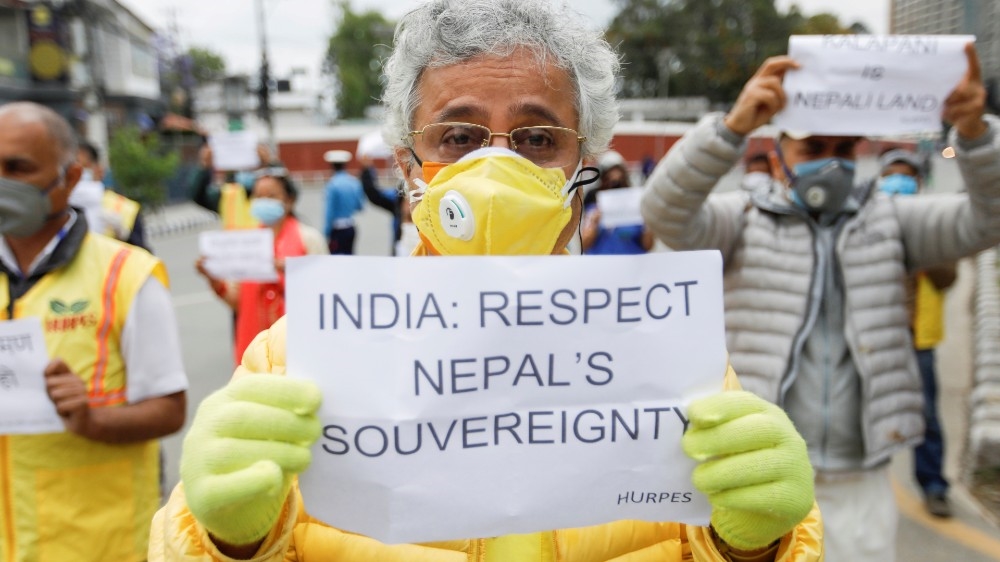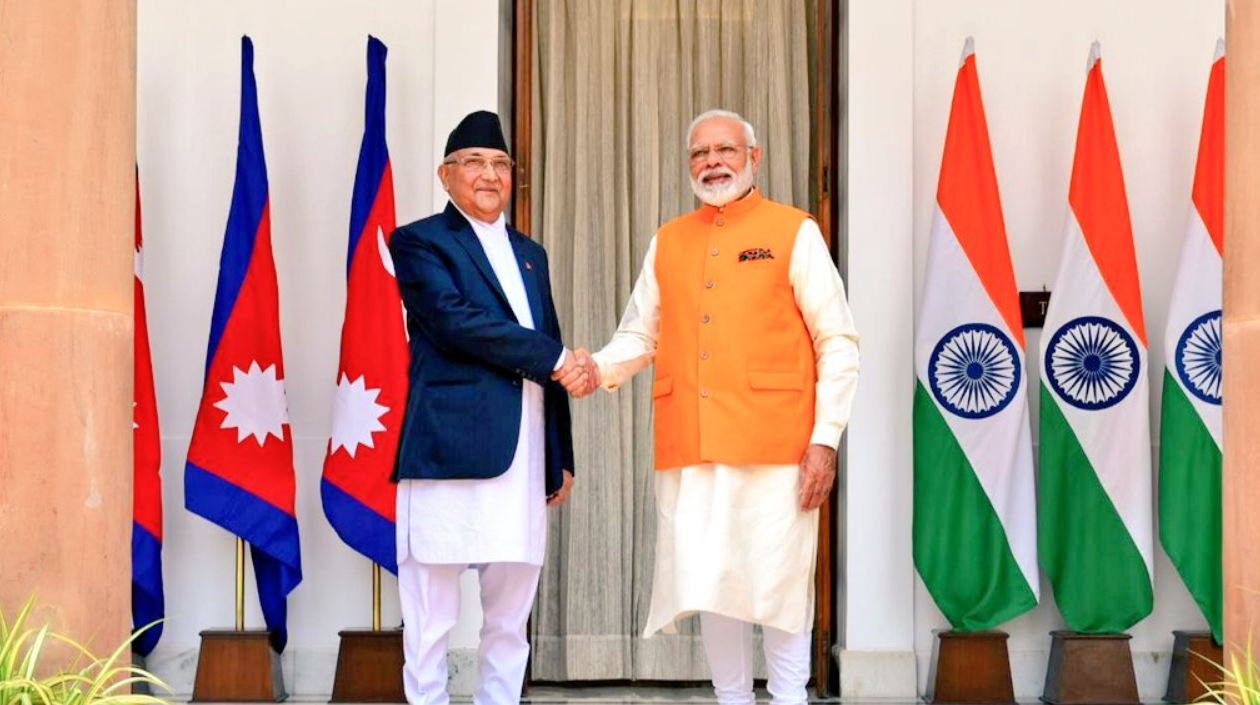Dr. Nihar Nayak covers Nepal, Bhutan, left-wing extremism, and cooperative security in South Asia. He holds a Ph.D. in International Politics from Jawaharlal Nehru University, was a Visiting Fellow in PRIO, Oslo where he did a special course on Peace Research and has also been a Visiting Faculty to the Center for the Study of Nepal, Faculty of Social Science, and Banaras Hindu University. He is an associate fellow of the Institute for Defense Studies and Analysis (IDSA) and has published a book named “Strategic Himalayas: Republican Nepal and External Power.” In an interview with KathmanduPati, he shares his view on recent Nepal-India disputes, growing anti-Indian sentiments in Nepal and policies to improve bilateral ties, among other issues. Excerpts:
Nepal issued its new map only after India failed to respond to Nepal’s protest letter for a long period of time. What is your analysis on these chain of events?
-When the government of India issued a new political map in November 2019, it was not targeted towards Nepal, but rather towards Jammu and Kashmir. While reorganizing the map, due to improvements in cartographic technology, some tweaks were made but India’s motive was not to encroach Nepal.
This was a matter of interpretation, which is now a debatable issue because India claims that it has not crossed Nepal’s territory and Nepal then claims these as its own. This can and should be resolved through dialogue.
There are two reasons why India didn’t hold a diplomatic dialogue after Nepal issued its note following India’s map release. Before November 2019, both Nepal and India had held a joint commission meeting in July, followed by a Prime Minister’s level meeting in August 2014. This Joint Commission meeting was at the Foreign Minister level.
On both occasions, the governments of India and Nepal agreed to identify Kalapani and Susta as the two disputed territories. They decided to form a Boundary Working Group (BMG) whose objective and was to demarcate the border and to re-establish all border pillars.
When this BWG was formed in July 2014, the initial term was only for 5 years but it couldn’t progress substantially, hence their tenure was extended to another 3 to 4 years. BWG was not in any position to facilitate the Foreign Ministry level meeting by 2019. This is why the government of India didn’t reach out for a dialogue.
Another political reason behind this was that by November 2019 the Minister of External Affairs was ready to retire in January and, according to Indian policies, 2 months before retirement they cannot make any major decisions or attend any major important meetings. At the same time, India’s ambassador to Nepal was about to retire in February.
India then decided to hold the discussions in the first week of April before the situation with Covid-19 began escalating but was forced to postpone it again. The media should take such technical and political issues into consideration before making any kind of statement.
In most India-Nepal related disputes, there are two views- one that India constantly brings up China’s name and then Nepal denies that influence, two that India wants bilateral discussions but it is Nepal that brings China in. What are your thoughts on this?
-The Indian government’s position, which we are aware of from the Indian spokesperson’s weekly meeting, is quite clear and is the official line. There is also the private line or as we call it, the ‘media line,’ because in India they enjoy maximum freedom and are free to interpret issues as they please.
The Pakistani issue and China issue was completely dominating the Indian media when Nepal released its new map and many media houses linked it with China, but this is the ‘media line’ and we have to be very clear that the government of India does not have any control over that.
Only the statements formally released by the Indian Government should be considered as the ‘official line,’ however, I have often seen that Nepali media and Nepali academia refer to only the media line. To avoid such conflict we should always refer to MEA outlines. The Government of India has never directly asserted that this border issue with Nepal is related to China.
As a researcher, I cannot deny the fact that China does play an indirect role. On November 20, 2008, Bamdev Gautam had made a statement after meeting a Chinese delegate in Kathmandu that the Kalapani border issue should be dissolved through a trilateral understanding between Nepal, India, and China.
But Kalapani is not a trijunction, and Nepal’s intent to pull China into the conversation was then questioned because Kalapani played a crucial role in the 1962 war for China, and the presence of Indian Military forces there would have signified a direct challenge to them.
The new Nepali map was also issued after India’s disagreements with China and Pakistan started gathering heat. Before that, the Ministry of Foreign Affairs in Nepal had issued a 5-lined press-release which only addressed Kalapani as a disputed area.
The road construction that started in March 2008 had been halted in 2013 due to technical problems and then completed only in 2020. The Nepal government knew about this, so why did they wait until now, when India was having issues with China and Pakistan, to release its new map?
 How do you see Nepal’s ties with China at a time when the Nepal-India relationship is deteriorating?
How do you see Nepal’s ties with China at a time when the Nepal-India relationship is deteriorating?
-Often, people will argue that Chinese influence is increasing all over Nepal and hence, India’s influence must be slipping away, or vice versa. But as a researcher, I see no link between the two whatsoever. The relationship between India and Nepal is historical and has been existing long before the concept of modern sovereign states.
Undoubtedly, Chinese influence has been there. However, it is not new. It has had such a relation with the Americas, South Africa, and other countries around the world. India’s relationship with Nepal has been more than just strategic. China is more worried about western influence in South Asian countries.India is not in competition with China in this regard.
I for one do not believe that there is an equidistant policy in the India-Nepal and Nepal-China relationship. Such policies are adopted only under similar arrangements. Nepal currently has an open border with India with 22 transit points but with China, it requires a visa to enter the country, that too at a single transit point.
As we know, many remarks by Indian leaders are strongly refuted by Nepalis especially if there are explicit or implicit statements about Nepal being in India’s sphere of influence. What is your opinion on the factors fueling such anti-India sentiments?
-India has a multi-party system and the two countries’ political parties have had close contact with each other. The relationship between the parties and its leaders has been very healthy and friendly with some political parties from India’s side occasionally making irresponsible mistakes.
However, after the border disputes occurred, our leaders have not made controversial statements. The PMs even had a phone conversation in April 2020, although all that they discussed was what measures to take to control the pandemic.
A recent statement by our External Affairs Minister regarding the birthplace of Gautam Budhha was inappropriate, but the MEA clarified within an hour that they had no such intentions, and issued a statement clearly stating that Buddha was born in Nepal.
India is trying to respect the Nepali people’s sensitivity and concern on such issues. Nepal is a sovereign state and sovereignty has to be asserted factually by Nepal itself. Nepal does not need to wait for another country to be sovereign.
What are your thoughts on the lockdown situation in Nepal compared or contrasted to the border dispute with India?
-I have specialized particularly in Himalayan politics and in my 14 years of experience, I have realized one thing since Nepal adopted democracy in 1990- that an anti-incumbency tactic does not ever work for the ruling party.
Even in India, the Manmohan Singh government lost the elections due to its anti-incumbency factor. Why? Because non-performers successfully blame India and then shift all the blame towards it, which the Nepali people then believe as being true.
As for the way in which the current government is handling the Covid-19 situation- they had an opportunity to divert the public’s attention away from the pandemic by using the border issue.
On April 10, the joint conversation between the two PMs of India and Nepal was held to discuss measures to collectively fight against the coronavirus situation.
On April 20, two top party leaders of Nepal demanded that Oli’s power be divided, leading the Oli administration to create two ordinances in the party agenda.
It was only after then that controversial statements began to be released from the Prime Minister’s office. He mentioned that the Indian side was more virulent than the Chinese side. After criticizing India’s national emblem- Satyamev Jayate, he then issued a new map.
The Nepali people themselves have begun showing mass public dissatisfaction with the present government. However, there has been blatant non-performance and non-deliverance.
The Enough is Enough campaign is another sign of that. They failed to contain the virus and due to the mismanagement, corruption in the distribution of testing kits occurred along with many other issues. And they’re using the India card to hide their inadequacy.
 What specific SMART (Specific, Measurable, Ambitious, Realistic, Time-Bound) policy recommendations would you have to improve Nepal and India’s bilateral relationship?
What specific SMART (Specific, Measurable, Ambitious, Realistic, Time-Bound) policy recommendations would you have to improve Nepal and India’s bilateral relationship?
-We’re passing through one of the most turbulent bumps in our relations. The Nepali government has been asking India to hold dialogues and India has continuously been silent on that. The latter government says that this dialogue is not possible unless Nepal brings some clarity on the map situation.
Nepal’s Foreign Minister Pradeep Gyawali made a statement that the map issued by the government is permanent and that there shall be no changes in it. If that is Nepal’s position then why would India go to dialogue with Nepal when the result is very much clear and Nepal has decided not to do anything?
The ball is now in Nepal’s court so Nepal should quickly find out a solution internally on how to have higher level dialogue because, unless there is any flexibility, India is not coming for dialogue. It is to be discussed on the technocratic level and not based on some emotional outrage.
But just because border dispute dialogue is not happening, does not mean other dialogues are on hold too. The August 17th meeting bilateral mechanism is going to meet and such mechanisms are very important to occur regularly. The people-people relation is one of the most important factors. It should continue as it is and ignore any initial conflicts.
The media has to play a more constructive role in our bilateral relations. They should always go with the formal political statement issued by the MEA or MOFA.
The media should try to improve relations rather than escalate tension between the two countries. The academic level discourse should continue at the joint-level and misunderstandings can be decreased through that way as well.
Sameer SJB Rana is the News Coordinator for Kathmandu Pati English covering politics, peace, conflict, security, defense, and diplomacy issues. He’s also Founder & CEO of SportIFY Nepal, Research Assistant for Princeton University’s Empirical Studies of Conflict Project and Microsoft Research, and an MPA grad student at Columbia University. He tweets @sameersjbrana.
Neha Shrestha is an intern at Kathmandu Pati English. She is a freshman at the Georgetown University School of Foreign Service in Qatar. She previously wrote for Nepal Traveller. Find her on LinkedIn as Neha Shrestha.